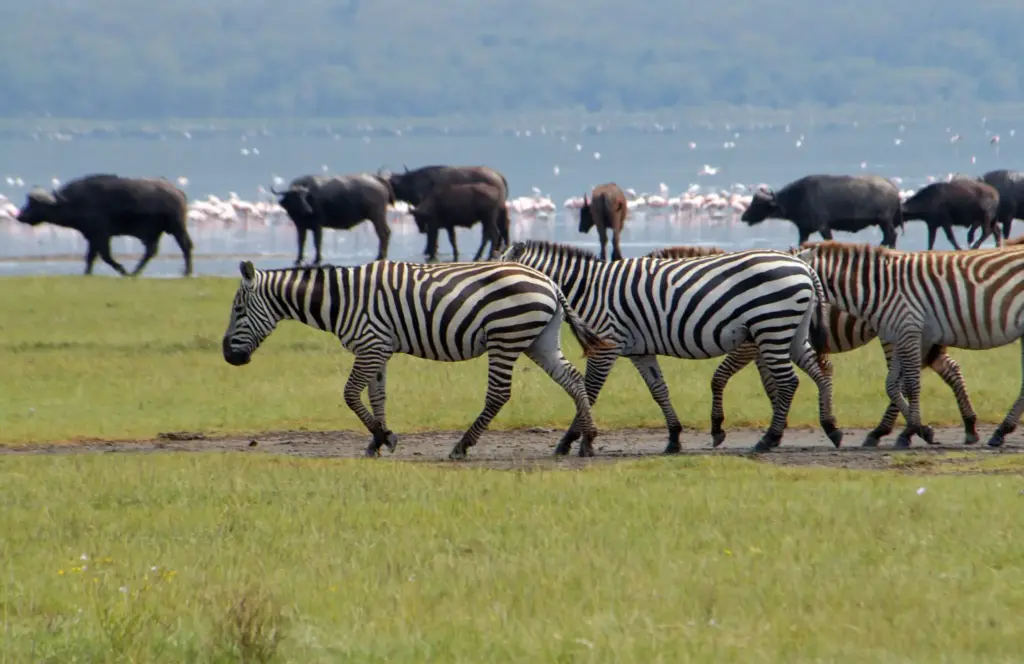Discover The Exclusive Beauty Of Kenya’s Lake Nakuru National Park
Lake Nakuru National Park is a good standalone trip if one has no time to visit the popular Maasai Mara and the Amboseli. The Park is located 160km from the capital Nairobi, approximately a 3-3.5 hour drive. The park has 3 gates which you may use depending on where you come from. The park is also accessible via flight. A 25-minute flight from Jomo Kenyatta International Airport (JKIA) in Nairobi. Adventurers using a flight to get to the park will land at Naishi airstrip inside the park and then they can do a game drive.

The park is said to have commenced early in the 50s as a bird viewing area and also a sport shooting area of birds. The park is also known as Bird Watchers Paradise due to the abundance of bird species that migrate from all over the globe. To be a little bit precise over 400 species. The park is in Nakuru City, found in the southern part of Nakuru City.
To be brief, Nakuru City is Kenya’s fourth-largest settlement area. The vegetation in the park can be well described to be unique comprising of marshes, acacia woodlands, euphorbia forest and bushy grasslands. The forest area is known to host the majority of the bird species. As the name suggests there is a lake in the park; Lake Nakuru.
The Big 5 in the Park
Lake Nakuru sits at an elevation of 1745m above sea level, having a mean depth of 1 foot, the deepest region being 6 feet deep. The Lake is well known because of its appearance from far which resembles a thin, bright pink blanket; this is due to the presence of many flamingoes that visit the lake to feed on the blue-green algae that grow on the lake due to the alkaline conditions of the waters in the lake which favour growth. The lake also comprises other birds such as the Egyptian goose, avocets and sacred ibis just to name a few. Within the vicinity of the lake, one may encounter other animals such as waterbucks, impalas and hippopotamuses. Besides being a bird watchers’ paradise, the park also boasts of having various animals which include: rhinoceroses (both black and white), lions, leopards, Rothschild giraffes, buffaloes, Olive baboons, Monkeys (vervets and colobus species), waterbucks, elands, Burchell zebras, impalas, gazelles and many others. Generally, the park hosts four of the big five missing only the elephant. The endangered Rothschild giraffes were introduced to the park in the year 1977. They were relocated from Western Kenya as a protection measure. Statistics have shown that the measure was the right move as their numbers have increased in the region.
In the later years (1987), not co-relating to the previous statement, it was established that the park had a large population of rhinos leading to the park being declared a rhino sanctuary. Further studies in the year 2009, highlighted that the park was home to over 25 eastern black rhinos and 70 southern white rhinos. Leopards’ sightings in the area have also increased significantly, though due to leopards’ nature sighting them might prove to be an uphill task. A sighting of the King of the jungle (the lion) may be realized in the park. Large pythons may be spotted in the park woodlands hanging on the trees. Buffaloes, baboons, zebras, gazelles, impalas and many other animals are relevantly easy to spot while in the park.
Top Activities to Do in the Park
- Venture into the wild by going for a game drive/safari.
- Visit the baboon cliff/ Out of Africa viewpoints for an amazing view and take a snap.
- Visit Makalia waterfalls (one can have a picnic in the area)
- Stop at the causeway area to have a glance at the birds and the lake.
- Camping/catch some Zzzzs in one of the lodges in the park.